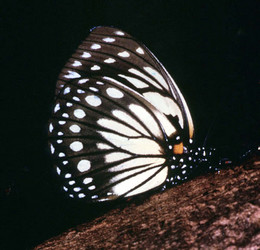Charaxini
Niklas Wahlberg and Andrew V. Z. Brower- Charaxes (monophyly uncertain)
- unplaced Charaxes species (not a clade) (non-monophyletic)
- Charaxes alpinus
- Charaxes alticola
- Charaxes amandae
- Charaxes analava
- Charaxes andara
- Charaxes andranodorus
- Charaxes antiquus
- Charaxes balfouri
- Charaxes barnsi
- Charaxes bernardii
- Charaxes bernsdorffi
- Charaxes brainei
- Charaxes cacuthis
- Charaxes carteri
- Charaxes chintechi
- Charaxes chittyi
- Charaxes chunguensis
- Charaxes daria
- Charaxes defulvata
- Charaxes diversiforma
- Charaxes dowsetti
- Charaxes dubiosus
- Charaxes ephyra
- Charaxes figini
- Charaxes fulgurata
- Charaxes fuscus
- Charaxes gallagheri
- Charaxes galleyanus
- Charaxes gerdae
- Charaxes grahamei
- Charaxes junius
- Charaxes karkloof
- Charaxes kheili
- Charaxes larseni
- Charaxes lemosi
- Charaxes loandae
- Charaxes lucyae
- Charaxes lydiae
- Charaxes manica
- Charaxes margaretae
- Charaxes marieps
- Charaxes martini
- Charaxes matakall
- Charaxes monteiri
- Charaxes murphyi
- Charaxes musakensis
- Charaxes nandina
- Charaxes nyikensis
- Charaxes octavus
- Charaxes odysseus
- Charaxes overlaeti
- Charaxes paradoxa
- Charaxes pelias
- Charaxes penricei
- Charaxes phaeus
- Charaxes phoebus
- Charaxes phraortes
- Charaxes pondoensis
- Charaxes prettejohni
- Charaxes saperanus
- Charaxes schiltzei
- Charaxes smilesi
- Charaxes subrubidus
- Charaxes taverniersi
- Charaxes tessieri
- Charaxes thysi
- Charaxes thomasius
- Charaxes usumbarae
- Charaxes vansoni
- Charaxes variata
- Charaxes velox
- Charaxes violetta
- Charaxes virescens
Introduction
Three palaeotropical genera of large, fruit-feeding nymphalids. Larvae have "horns" on the head capsule and bifid "tails" like those of Satyrinae. The recent molecular analysis of Aduse-Poku et al. (2009) implies quite strongly that Charaxes is paraphyletic with respect to both Euxanthe and Polyura. However, the latter two genera are clearly monophyletic.
Discussion of Phylogenetic Relationships
The list of species included here below the link to Charaxes are those species that have not been sampled in the phylogenetic studies upon which the tree is based or assigned to a species group by the cited authors.
They ARE part of Charaxes, but are listed here because including them within Charaxes makes Charaxes and Charaxini equivalent groups and collapses the tribe, due to the apparent paraphyly of the former.
References
Ackery PR, Smith CR, and Vane-Wright RI eds. 1995. Carcasson's African butterflies. Canberra: CSIRO.
Aduse-Poku, K., Vingerhoedt, E.,Wahlberg, N. 2009. Out-of-Africa again: A phylogenetic hypothesis of the genus Charaxes (Lepidoptera: Nymphalidae) based on 5 gene regions. Mol. Phylogenet. Evol. 53, 463-478.
Larsen, T. B. 2005 Butterflies of West Africa. Stenstrup, Denmark: Apollo Books.
Title Illustrations

| Scientific Name | Charaxes jasius |
|---|---|
| Location | Ourense, Galicia, Spain |
| Specimen Condition | Live Specimen |
| Source | charaxes jasius |
| Source Collection | Flickr |
| Image Use |
 This media file is licensed under the Creative Commons Attribution-NonCommercial-ShareAlike License - Version 2.0. This media file is licensed under the Creative Commons Attribution-NonCommercial-ShareAlike License - Version 2.0.
|
| Copyright | © 2006 Julio Iglesias |
| Scientific Name | Polyura hebe |
|---|---|
| Location | Singapore |
| Specimen Condition | Live Specimen |
| Source | Polyura hebe plautus (Plain Nawab) |
| Source Collection | Flickr |
| Image Use |
 This media file is licensed under the Creative Commons Attribution-NonCommercial-ShareAlike License - Version 2.0. This media file is licensed under the Creative Commons Attribution-NonCommercial-ShareAlike License - Version 2.0.
|
| Copyright | © 2006 AK |
| Scientific Name | Euxanthe wakefieldi |
|---|---|
| Location | Gombe National Park, Tanzania |
| Specimen Condition | Live Specimen |
| Identified By | David Bygott |
| Life Cycle Stage | Adult |
| View | Lateral |
| Copyright |
© 2004
David Bygott

|
About This Page
Niklas Wahlberg

University of Turku, Finland
Andrew V. Z. Brower

Middle Tennessee State University, Murfreesboro, Tennessee, USA
Correspondence regarding this page should be directed to Niklas Wahlberg at
niklas.wahlberg@utu.fi
and Andrew V. Z. Brower at
abrower@mtsu.edu
Page copyright © 2012 Niklas Wahlberg and Andrew V. Z. Brower
 Page: Tree of Life
Charaxini .
Authored by
Niklas Wahlberg and Andrew V. Z. Brower.
The TEXT of this page is licensed under the
Creative Commons Attribution License - Version 3.0. Note that images and other media
featured on this page are each governed by their own license, and they may or may not be available
for reuse. Click on an image or a media link to access the media data window, which provides the
relevant licensing information. For the general terms and conditions of ToL material reuse and
redistribution, please see the Tree of Life Copyright
Policies.
Page: Tree of Life
Charaxini .
Authored by
Niklas Wahlberg and Andrew V. Z. Brower.
The TEXT of this page is licensed under the
Creative Commons Attribution License - Version 3.0. Note that images and other media
featured on this page are each governed by their own license, and they may or may not be available
for reuse. Click on an image or a media link to access the media data window, which provides the
relevant licensing information. For the general terms and conditions of ToL material reuse and
redistribution, please see the Tree of Life Copyright
Policies.
- First online 25 September 2006
- Content changed 12 March 2012
Citing this page:
Wahlberg, Niklas and Andrew V. Z. Brower. 2012. Charaxini . Version 12 March 2012 (under construction). http://tolweb.org/Charaxini/70250/2012.03.12 in The Tree of Life Web Project, http://tolweb.org/












 Go to quick links
Go to quick search
Go to navigation for this section of the ToL site
Go to detailed links for the ToL site
Go to quick links
Go to quick search
Go to navigation for this section of the ToL site
Go to detailed links for the ToL site